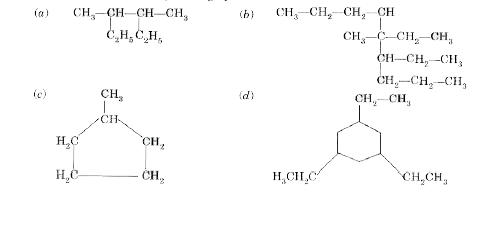CH3−C∣CH2H−CH=CH2+HBr→A (predominant), A is
CH3−C∣CH3H−C∣BrH−CH3
CH3−C∣CH3H−CH2−CH2Br
CH3−Br∣C∣CH3−CH2−CH3
None of the above
The correct Answer is:C
To solve the problem, we need to determine the predominant product (A) formed when the given alkene reacts with HBr. Let's break down the steps involved in this reaction:
Step 1: Identify the Alkene Structure
The given alkene is CH₃-CH₂-CH=CH₂. This structure consists of a four-carbon chain with a double bond between the third and fourth carbon atoms.
Step 2: Understand the Reaction with HBr
When an alkene reacts with HBr, the reaction proceeds via an electrophilic addition mechanism. The double bond acts as a nucleophile and attacks the hydrogen (H⁺) from HBr, leading to the formation of a carbocation.
Step 3: Formation of the Carbocation
1. The double bond between the carbon atoms breaks, and H⁺ adds to one of the carbons involved in the double bond.
2. The other carbon will now have a positive charge, forming a carbocation.
3. In this case, the more stable carbocation will be favored.
Step 4: Determine the Stability of Carbocations
- If H⁺ adds to the terminal carbon (C1), a primary carbocation (1°) is formed.
- If H⁺ adds to the second carbon (C2), a secondary carbocation (2°) is formed.
- If H⁺ adds to the third carbon (C3), a tertiary carbocation (3°) is formed.
The tertiary carbocation is the most stable due to hyperconjugation and inductive effects from surrounding alkyl groups.
Step 5: Nucleophilic Attack by Br⁻
Once the carbocation is formed, the bromide ion (Br⁻) will attack the positively charged carbon. Since we formed a tertiary carbocation, Br⁻ will attack this carbon.
Step 6: Write the Final Product
The final product (A) will be formed by attaching Br to the carbon where the carbocation was formed. The structure of the product will be:
- CH₃-CH(Br)-CH₂-CH₃
Final Answer
The predominant product A is CH₃-CH(Br)-CH₂-CH₃.
The given alkene is CH₃-CH₂-CH=CH₂. This structure consists of a four-carbon chain with a double bond between the third and fourth carbon atoms.
When an alkene reacts with HBr, the reaction proceeds via an electrophilic addition mechanism. The double bond acts as a nucleophile and attacks the hydrogen (H⁺) from HBr, leading to the formation of a carbocation.
1. The double bond between the carbon atoms breaks, and H⁺ adds to one of the carbons involved in the double bond.
2. The other carbon will now have a positive charge, forming a carbocation.
3. In this case, the more stable carbocation will be favored.
- If H⁺ adds to the terminal carbon (C1), a primary carbocation (1°) is formed.
- If H⁺ adds to the second carbon (C2), a secondary carbocation (2°) is formed.
- If H⁺ adds to the third carbon (C3), a tertiary carbocation (3°) is formed.
Once the carbocation is formed, the bromide ion (Br⁻) will attack the positively charged carbon. Since we formed a tertiary carbocation, Br⁻ will attack this carbon.
The final product (A) will be formed by attaching Br to the carbon where the carbocation was formed. The structure of the product will be:
- CH₃-CH(Br)-CH₂-CH₃
The predominant product A is CH₃-CH(Br)-CH₂-CH₃.
Topper's Solved these Questions
- BOOK - FIITJEECHAPTER - HYDROCARBONSEXERCISE - ASSIGNMENT PROBLEMS (OBJECTIVE) Level-II18videos
HYDROCARBONS
- BOOK - FIITJEECHAPTER - HYDROCARBONSEXERCISE - ASSIGNMENT PROBLEMS (OBJECTIVE) Level-II Reasoning type questions2videos
HYDROCARBONS
- BOOK - FIITJEECHAPTER - HYDROCARBONSEXERCISE - ASSIGNMENT PROBLEMS (SUBJECTIVE) Level-II1videos
HYDROCARBONS
- BOOK - FIITJEECHAPTER - GENERAL ORGANIC CHEMISTRYEXERCISE - SINGLE INTEGER ANSWER TYPE QUESTIONS14videos
GENERAL ORGANIC CHEMISTRY
- BOOK - FIITJEECHAPTER - IONIC EQUILIBRIUM EXERCISE - SINGLE INTEGER ANSWER QUESTIONS4videos
IONIC EQUILIBRIUM
Similar Questions
Knowledge Check
- Question 1 - Select One
H2C−CH∣CH3−CH=CH2+HBr→A
ACH3CH∣CH3−CH∣Br−CH3BCH3CH∣CH3−CH2−CH3BrCCH3−Br∣C∣CH3−CH2CH3DCH3−CH∣Br−CH∣CH3−CH3 - Question 2 - Select One
CH3CHCH∣CH3=CH2+HBr→A,A (predominant is
ACH3CHCH∣CH3C∣BrH2BCH3CHCH2CH2Br∣CH3CCH3Br∣C∣CH3CH2CH3DNone of these - Question 3 - Select One
CH3−C∣CH3H−CH=CH2+HBr→ (product) which is predominate , X is -
ACH3−CH∣CH3−CH2CH2BrBCH3−Br∣C∣CH3−CH2−CH3CCH3−CH∣CH3−CH∣Br−CH3DNone is correct
Give IUPAC names for the following hydrocarbons :

(e) CH3−CH∣CH3−CH2−CH2−CH∣CH3−CH∣CH3−CH2−CH3View SolutionCH3−C∣CH3H−CH=CH2+HBrPeroxide−−−−→A (predominant), A is
View SolutionIUPAC name of the compound CH3−C∣CH3H−CH2−CH2Cl is -
View SolutionIUPAC name of CH3−CH∣CH3−CH2−CH=CH2 is
View SolutionThe IUPAC name of
CH3−C∣CH3H−CH2−CH2−OH isView Solution

